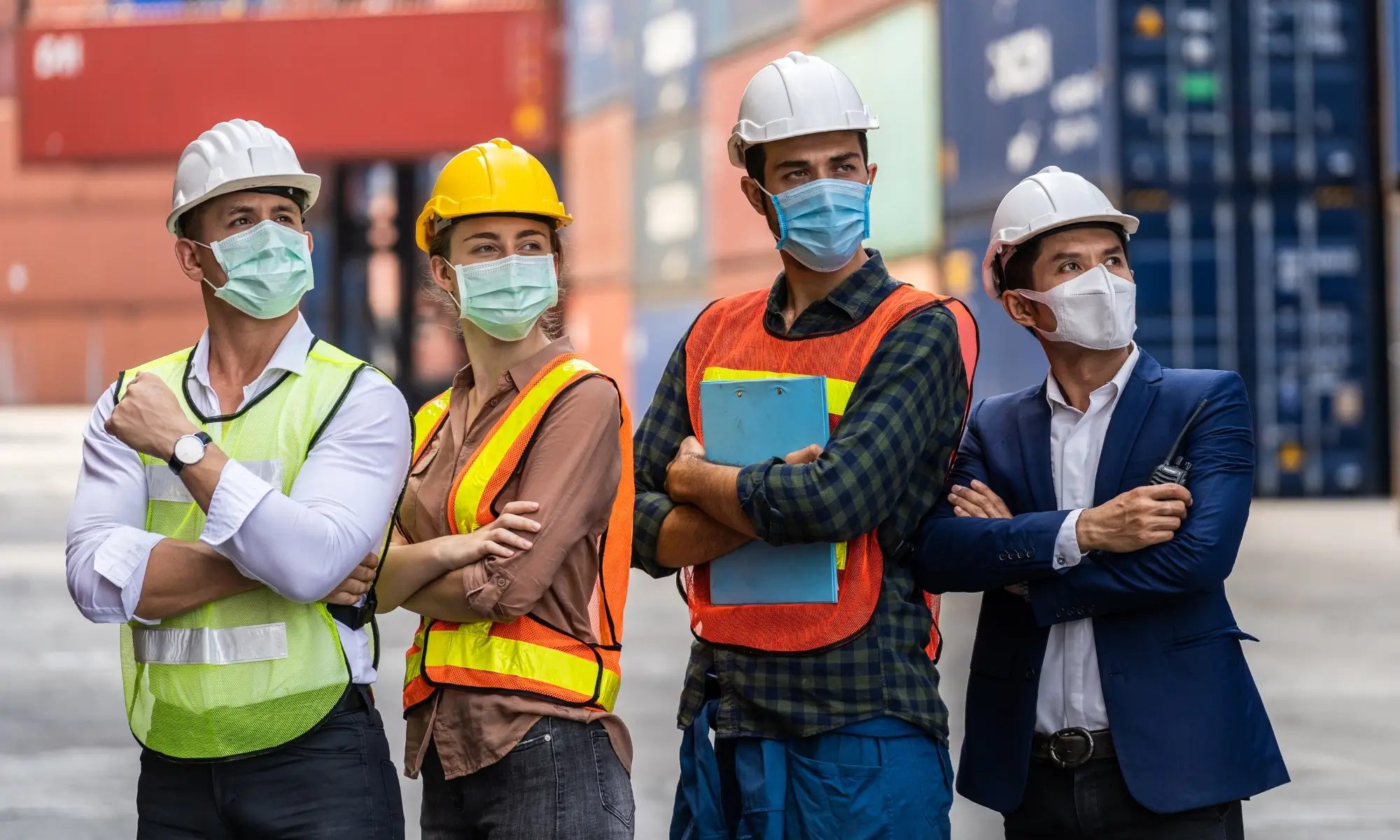Occupational Health and Safety (OHS), also known as Occupational Safety and Health (OSH), refers to the policies, practices, and regulations that protect employees from workplace hazards and ensure a safe and healthy work environment. It covers many aspects, including hazard identification, risk mitigation, employee training, health monitoring, and legal compliance.
In today’s work environment, OHS is more than just a legal obligation—it’s a strategic approach to improving employee well-being and organizational efficiency. A well-implemented OHS program can reduce workplace accidents, increase productivity, and create a culture where employees feel valued and protected.
This article explores the importance of OHS, the key components of an effective OHS program, different types of hazards, challenges in OHS management, and best practices for implementing and maintaining workplace safety.

What is Occupational Health and Safety (OHS)
Occupational Health and Safety (OHS), also known as Occupational Safety and Health (OSH), is a multidisciplinary field focused on safeguarding the health, safety, and welfare of individuals in the workplace. It involves anticipating, recognizing, evaluating, and controlling hazards arising in or from the workplace that could impair workers’ health and well-being while also considering the potential impact on surrounding communities and the general environment.
The primary objective of OHS is to prevent work-related injuries, illnesses, and fatalities by creating a safe and healthy work environment. This is achieved through the implementation of various strategies, including:
- Hazard Identification and Risk Assessment: Systematically identifying potential workplace hazards and assessing the associated risks.
- Development and Enforcement of Safety Standards: Establishing regulations and guidelines to mitigate identified risks. For example, the Occupational Safety and Health Administration (OSHA) in the United States sets and enforces standards to ensure safe working conditions.
- Education and Training: Providing workers and employers with the necessary knowledge and skills to recognize hazards and implement safe work practices.
- Health Surveillance and Monitoring: Regularly monitoring workers’ health to detect early signs of occupational diseases and implement timely interventions.
By integrating these components, OHS aims to foster a culture of safety that protects workers and enhances overall productivity and job satisfaction.
Why Occupational Health and Safety is Important
Prioritizing occupational health and safety benefits both employers and employees in several key ways:
- Reduced Risk of Workplace Accidents and Injuries: By identifying hazards and implementing effective safety measures, businesses can prevent injuries, illnesses, and fatalities. This protects employees and minimizes disruptions to business operations.
- Increased Productivity and Efficiency: A safe work environment leads to fewer absences, improved employee focus, and higher work output. When workers feel safe, they are more motivated and engaged.
- Improved Employee Morale and Retention: Employees are likelier to stay with a company committed to their safety and well-being. A positive work environment fosters trust and job satisfaction.
- Reduced Costs and Insurance Premiums: Fewer workplace incidents mean lower costs related to workers’ compensation, medical expenses, and legal claims. This also helps reduce insurance premiums.
- Legal Compliance and Reduced Liability: Meeting OHS regulations helps avoid fines and penalties while protecting the organization from potential lawsuits and reputational damage.

Key Components of an Effective OHS Program
A successful OHS program relies on several core components that work together to create a safe and compliant work environment:
- Hazard Identification and Risk Assessment: Regular workplace inspections and audits help identify potential risks such as faulty equipment, chemical exposure, poor ergonomics, and unsafe work practices.
- Employee Training and Awareness: All employees should be trained on safety procedures, equipment use, and emergency response. Taking health and safety courses can further enhance employees’ understanding of workplace hazards and best practices, helping them respond effectively in critical situations. Training should be ongoing and updated regularly to reflect changes in regulations or workplace conditions.
- Use of Personal Protective Equipment (PPE): Employers must provide the appropriate PPE—such as helmets, gloves, safety glasses, and respirators—depending on the nature of the work and the identified hazards.
- Incident Reporting and Investigation: Establish a clear process for employees to report accidents, injuries, and near-misses. Investigate incidents to identify root causes and prevent recurrence.
- Health Monitoring and Wellness Programs: Monitoring employee health, especially for jobs that expose them to hazardous substances or require high physical demands, helps prevent chronic health issues and improves overall well-being.
- Emergency Preparedness and Response: Develop emergency response plans for fire, chemical spills, medical emergencies, and other critical situations. Conduct regular drills to ensure employees know how to respond effectively.

Types of Workplace Hazards
Workplace hazards vary by industry and job type, but they generally fall into the following categories:
1. Physical Hazards
- Unsafe machinery
- Falling objects
- Slippery floors
- Excessive noise or vibration
- Extreme temperatures
2. Chemical Hazards
- Exposure to toxic substances, cleaning agents, and gases
- Risk of burns, respiratory issues, or skin irritation
- Proper handling, storage, and disposal are essential
3. Biological Hazards
- Exposure to viruses, bacteria, mold, and fungi
- Potential for infection, allergic reactions, and long-term health issues
- Proper hygiene and protective gear are critical
4. Ergonomic Hazards
- Poor workstation design
- Improper lifting techniques
- Repetitive strain injuries (e.g., carpal tunnel syndrome)
- Adjusting furniture, equipment, and work tasks helps reduce risk
5. Psychological Hazards
- Work-related stress, harassment, and burnout
- Poor work-life balance
- Lack of employee support and recognition
- Addressing mental health through supportive policies is essential

OHS Regulations and Global Practices
Different countries have established their own OHS frameworks and agencies to regulate and enforce workplace safety:
- United States: The Occupational Safety and Health Act (1970) established OSHA (Occupational Safety and Health Administration) and NIOSH (National Institute for Occupational Safety and Health).
- United Kingdom: The Health and Safety Executive (HSE) enforces the Health and Safety at Work Act (1974).
- Canada: The Canadian Centre for Occupational Health and Safety (CCOHS) oversees OHS laws and training programs.
- Australia: Work Health and Safety (WHS) regulations are managed by Safe Work Australia.
- France: The Health at Work Act (2021) strengthened workplace health and safety standards.
- Brazil: The Brazilian Regulatory Standards (NR) define workplace safety requirements.
- Mexico: OHS standards are part of the Federal Labor Law and Social Security Law.

Best Practices for Promoting Occupational Health and Safety
To establish and maintain a strong OHS program, businesses should follow these best practices:
- Management Commitment: Leadership must actively promote a culture of safety by providing resources and participating in safety programs.
- Employee Participation: Encourage workers to report hazards, suggest improvements, and take part in safety initiatives.
- Regular Training: Conduct ongoing training on equipment use, hazard recognition, and emergency response.
- Use of PPE: Ensure all employees have access to and are properly trained to use PPE.
- Monitor and Improve: Conduct regular inspections and adapt policies as new risks and regulations emerge.
- Incident Investigation: Analyze accidents and near-misses to strengthen safety measures.
- Mental Health Support: Implement stress management programs and provide access to counseling.

Impact of OHS on Business and Employees
Occupational Health and Safety (OHS) has a direct and measurable impact on both businesses and employees. A well-implemented OHS program not only prevents accidents and injuries but also improves business performance, employee morale, and overall work culture. Here’s how OHS benefits both businesses and employees:
Impact on Businesses
1. Reduced Workplace Incidents and Associated Costs
Implementing effective OHS measures reduces the likelihood of accidents, injuries, and illnesses. Fewer incidents lead to lower costs related to:
- Workers’ compensation claims
- Medical expenses
- Property damage
- Legal fees and penalties
For example, according to OSHA, workplace fatalities in the U.S. have decreased by 63% since the introduction of the OSH Act in 1970.
2. Lower Insurance Premiums
Fewer workplace incidents result in fewer insurance claims, which leads to lower insurance premiums. Insurance companies often reward companies with strong safety records through reduced rates, which lowers overall operational costs.
3. Increased Productivity and Efficiency
A safe work environment means fewer disruptions caused by accidents and injuries. When employees feel safe and healthy, they are more focused and productive.
- Reduced absenteeism due to injuries or illnesses
- Improved employee performance and efficiency
- Better quality of work
4. Improved Employee Retention and Recruitment
Companies with strong OHS programs are more attractive to top talent. Employees are more likely to stay with an employer that demonstrates a commitment to their safety and well-being.
- Lower turnover rates
- Easier to attract skilled professionals
- Enhanced company reputation
5. Regulatory Compliance and Avoidance of Legal Penalties
Failure to meet OHS regulations can result in heavy fines, penalties, and legal action. Maintaining compliance helps businesses avoid:
- Financial penalties
- Legal liability
- Damage to reputation
For example, OSHA fines can reach up to $15,625 per violation for serious offenses, with additional daily penalties for uncorrected hazards.
6. Stronger Organizational Culture
A commitment to safety fosters a culture of accountability and care within the organization. Employees feel valued and are more likely to take ownership of their work, leading to improved overall morale and teamwork.
Impact on Employees
1. Improved Physical and Mental Well-Being
Employees working in a safe environment are less likely to suffer from work-related injuries or illnesses. Access to proper protective equipment, ergonomic workstations, and mental health support enhances overall well-being.
2. Reduced Stress and Anxiety
When employees know that their safety is a priority, they feel more secure and confident in their roles. This reduces stress levels, improves concentration, and enhances overall job satisfaction.
3. Greater Job Satisfaction and Morale
Employees are more engaged and motivated when they feel their employer values their health and safety. A positive work environment leads to:
- Higher job satisfaction
- Lower absenteeism
- Stronger employee loyalty
4. Empowerment and Participation
OHS programs that involve employees in safety decisions empower them to take responsibility for their safety and that of their coworkers. Employees are more likely to report hazards and suggest improvements when they feel that their input is valued.
5. Professional Development and Skills Improvement
Safety training and emergency response drills help employees build valuable skills that can enhance their career prospects. Understanding safety procedures and proper equipment use increases their competency and confidence.
6. Protection Against Long-Term Health Issues
By managing exposure to harmful substances and improving ergonomic conditions, OHS programs help prevent chronic health issues such as:
- Respiratory problems
- Musculoskeletal disorders
- Hearing loss
- Repetitive strain injuries
A strong Occupational Health and Safety (OHS) program creates a win-win situation for businesses and employees. For businesses, it reduces costs, improves productivity, ensures regulatory compliance, and strengthens company reputation. For employees, it creates a safer, healthier, and more supportive work environment, boosting morale and job satisfaction. By prioritizing OHS, companies not only protect their workforce but also create the foundation for long-term success and sustainability.

Challenges in OHS Management
Managing Occupational Health and Safety (OHS) is essential for creating a safe and productive work environment. However, implementing and maintaining an effective OHS program comes with several challenges. These challenges stem from factors such as complex regulations, changing workplace environments, employee behavior, and resource limitations. Understanding these challenges is key to developing effective strategies to overcome them.
1. Compliance with Complex and Changing Regulations
OHS regulations vary across countries, industries, and jurisdictions, making compliance a major challenge.
- National and local governments frequently update safety regulations, requiring businesses to stay informed and adapt quickly.
- Global companies face the additional burden of complying with different regulations in multiple countries.
- Non-compliance can result in fines, legal action, and reputational damage.
Solution:
- Employ dedicated OHS officers to monitor regulatory changes.
- Develop flexible safety programs that can adapt to new regulations.
- Partner with legal advisors or compliance consultants.
2. Limited Resources and Budget Constraints
Many organizations, especially small and medium-sized businesses, struggle with limited budgets for OHS initiatives.
- Investing in safety equipment, employee training, and health monitoring programs can be costly.
- Budget limitations can result in inadequate safety measures and under-trained staff.
Solution:
- Focus on high-impact, low-cost safety measures.
- Apply for government grants or safety program funding.
- Implement phased safety improvements to spread costs over time.
3. Employee Resistance and Lack of Engagement
Employee participation is critical for a successful OHS program, but resistance to change is common.
- Employees may see new safety protocols as inconvenient or unnecessary.
- Lack of understanding about the importance of OHS can lead to non-compliance.
- A negative safety culture can result in underreporting of incidents and near-misses.
Solution:
- Involve employees in the development of safety programs.
- Provide clear communication on the benefits of safety initiatives.
- Encourage a culture of accountability and reward proactive safety behavior.
4. Balancing Productivity and Safety
Some businesses face pressure to meet production targets or deadlines, which can lead to shortcuts and unsafe practices.
- Employees may feel pressured to prioritize productivity over safety.
- Unsafe behavior, such as ignoring safety protocols to save time, increases the risk of accidents.
Solution:
- Integrate safety into production goals.
- Monitor production processes to identify conflicts between safety and productivity.
- Reinforce that safety and efficiency are not mutually exclusive.
5. Managing a Diverse and Evolving Workforce
Workforce diversity presents unique challenges in OHS management:
- Language barriers and cultural differences can affect safety communication.
- Older employees may have different physical capabilities compared to younger workers.
- Temporary and contract workers may lack proper training and experience.
Solution:
- Offer training in multiple languages and adapt communication styles.
- Provide customized safety measures for different age groups and physical abilities.
- Ensure that all temporary staff receive proper safety training.
6. Insufficient Training and Knowledge
Inadequate training is a common cause of workplace accidents and injuries.
- Employees may not understand how to use equipment properly.
- Lack of awareness about potential hazards increases the likelihood of accidents.
- Poor emergency preparedness can lead to confusion and injury during crises.
Solution:
- Implement regular and mandatory safety training.
- Provide refresher courses to reinforce safety practices.
- Conduct emergency response drills to improve preparedness.
7. Mental Health and Psychological Safety
Traditional OHS programs often focus on physical safety while neglecting mental health.
- Stress, fatigue, and harassment can lead to reduced productivity and higher accident rates.
- Employees may hesitate to report mental health issues due to stigma.
- Poor work-life balance can increase burnout and accidents.
Solution:
- Include mental health support in OHS programs.
- Provide confidential counseling services.
- Encourage open communication about mental health issues.
8. Technological and Environmental Changes
Rapid advancements in technology and changing environmental conditions introduce new risks.
- Automation and AI introduce complex machinery that requires specialized safety measures.
- Climate change increases risks from extreme weather, heat stress, and environmental hazards.
- New work models (e.g., remote work) present unique safety challenges.
Solution:
- Update OHS programs to include technology-based risks.
- Develop heat stress and natural disaster response plans.
- Address remote work challenges, such as ergonomic hazards and isolation.
9. Poor Reporting and Incident Investigation
Underreporting of safety incidents prevents businesses from addressing root causes.
- Fear of punishment or job loss can discourage employees from reporting incidents.
- Lack of thorough investigation can lead to recurring issues.
Solution:
- Create a non-punitive reporting culture.
- Encourage anonymous reporting.
- Conduct thorough investigations and implement corrective actions.
10. Supply Chain and Contractor Safety
Businesses that rely on external suppliers or contractors face challenges in ensuring consistent safety standards.
- Contractors may not follow the same OHS protocols as the parent company.
- Supply chain disruptions can lead to unsafe work practices.
Solution:
- Include OHS requirements in supplier and contractor agreements.
- Monitor contractor compliance through audits and inspections.
- Provide safety training to contractors and suppliers.
Managing occupational health and safety is a complex but essential task for any business. Compliance issues, employee resistance, limited resources, and balancing productivity with safety require strategic solutions. By addressing these challenges head-on and fostering a strong safety culture, businesses can create safer work environments, reduce incident rates, and improve overall employee satisfaction and operational efficiency.
Conclusion
Occupational Health and Safety (OHS) is not just a legal requirement—it’s a strategic asset for any business. A strong OHS program protects workers, improves operational efficiency, and strengthens employee morale. By identifying hazards, enforcing safety protocols, and supporting employee well-being, companies can create a work environment that is both safe and productive.
Investing in OHS is an investment in the future of the business and its employees. When safety becomes a core value, businesses thrive, and employees feel valued and protected.

